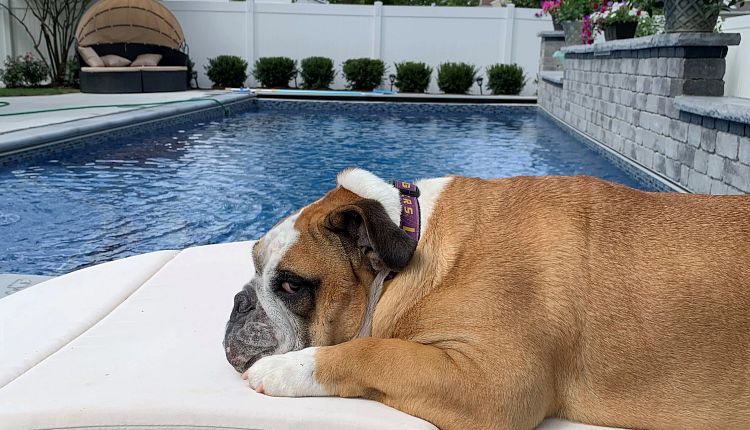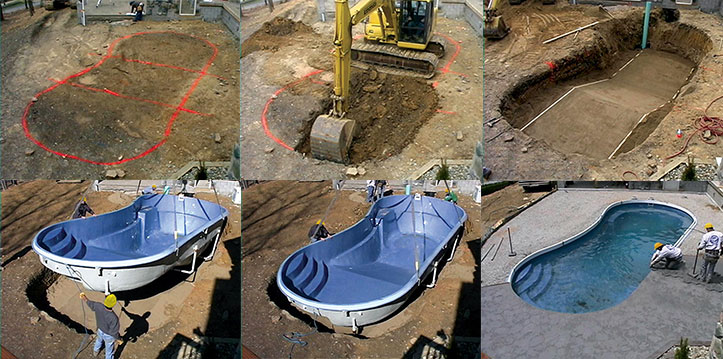Birthdays and holidays are best spent in and around your backyard pool and no party is complete without guests. Family fun usually includes the family pet, so how can you safely swim with your dog? Keep reading to find 4 easy ways to make your inground pool safe for your puppy.
1. Mark Ramps and Steps as Exit Points
The first way to make your pool safe for dogs that like to swim is to include ramps and steps but also to clearly mark them. While many animals might be happy to jump into a pool, none can scramble out of a pool without a feature that helps them. Most dogs are unable to use a ladder like their human family members, instead they need a ramp or steps.
Although Fido might be able to swim around and find the steps, they could have trouble if there’s an accident and he panics. Place a large, stationary object that your pets can look for near the exit will help them quickly find the exit point, even if they’re scared and panicking. A recognizable object doesn’t need to be ugly, but it should be large and different from everything else around your pool. A unique chair or umbrella would work well.
Ledges and benches can also provide areas of respite while in the water, offering places they can rest. While not necessary, consider including a tanning ledge or in-water benches in your pool’s design. A shallow end is rarely shallow enough for a pet to stand and keep their head above water, but these features can be made shallow enough for even small animals.
2. Monitor Your Pool’s Chlorine
Chlorine is considered safe to use in pools that animals swim in when used in the recommended amounts. Common pool activities, like swimming, do not pose a serious threat to dogs. No matter what, it’s important to keep pool chemicals locked up and stored safely away from where pets or children could accidentally access them.
For the most part, chlorine’s effects on dogs are similar to its effects on people. Drinking a little pool water won’t seriously harm your pets, although you shouldn’t encourage the habit. The most common issues that arise are minor skin irritations and bloodshot eyes. To reduce the risk of skin irritations, you should rinse off your pet after a swim in your pool, just as you ought to take a quick shower after going for a dip. Redness in the eyes comes from chloramines in the water, which is a sign that the chlorine levels are actually too low, not too high.
As we explored in the first part of this series, dogs and other pets will introduce more matter that promotes algae growth into your pool, only increasing the importance of proper pool maintenance. You’ll need to test your pool more frequently when pets are in it. It’s recommended you become well versed in checking your chlorine and pH levels and that you check them regularly. You can always bring your pool water to a local independent dealer to test as well.
3. Keep Potable Water Handy
When you’re around water, it’s easy to forget to drink even though it’s an important step when spending time enjoying outdoor activities. Both people and pets are susceptible to heat stroke while playing in the water. You don’t want your animals drinking too much pool water, but you also don’t want them becoming dehydrated. Having drinkable water nearby will help them stay hydrated while they’re in and out of your pool.
Providing drinkable water can be as simple as placing a water dish within your pool fence boundary. For added fun, set up a sprinkler that can also be used for rinsing off after swimming.

4. Add a Safety Cover
If you have a fenced in yard, your pup might enjoy roaming freely, however, consider a safety cover if you don’t want them swimming unsupervised. There are many pool covers that provide valuable insulation and keep debris out of pools, but certain types of covers are dangerous to both children and pets. Automatic safety covers and solid and mesh safety covers protect pets from becoming trapped while unsupervised.
Safety covers differ from other pool covers in two important ways. First, to be called a safety cover, a pool cover must be able to support the weight equivalent of one child and two adults. This means that they’re strong enough to support a full-grown, large dog. Second, safety covers don’t leave a gap between the cover and the side of the pool, so pets can’t fall in. If an animal falls onto a covered pool, they can often find the way out. Eliminating any gap prevents drowning among unsupervised pets.
Automatic safety covers can be easily deployed in minutes. Solid and mesh safety covers are perfect for pool owners who winterize their pool.
These 4 fast facts will be useful if you already have a pool and want to invite your pup to the next pool party. If you’re still early in the pool purchasing process, learn more about choosing the best pool material for your pet in the first part of our pools and pets series.







Join the discussion